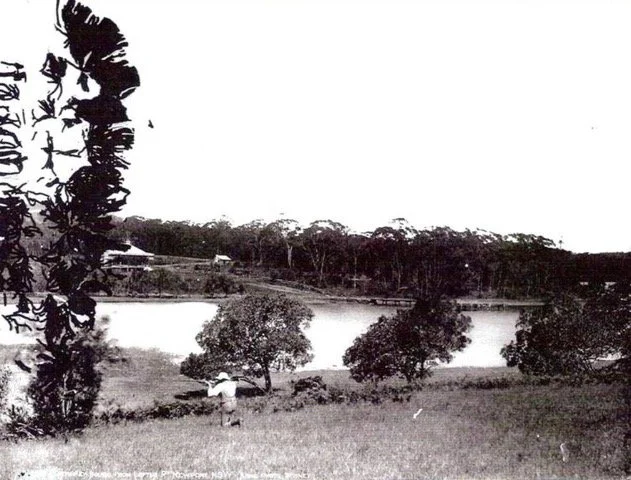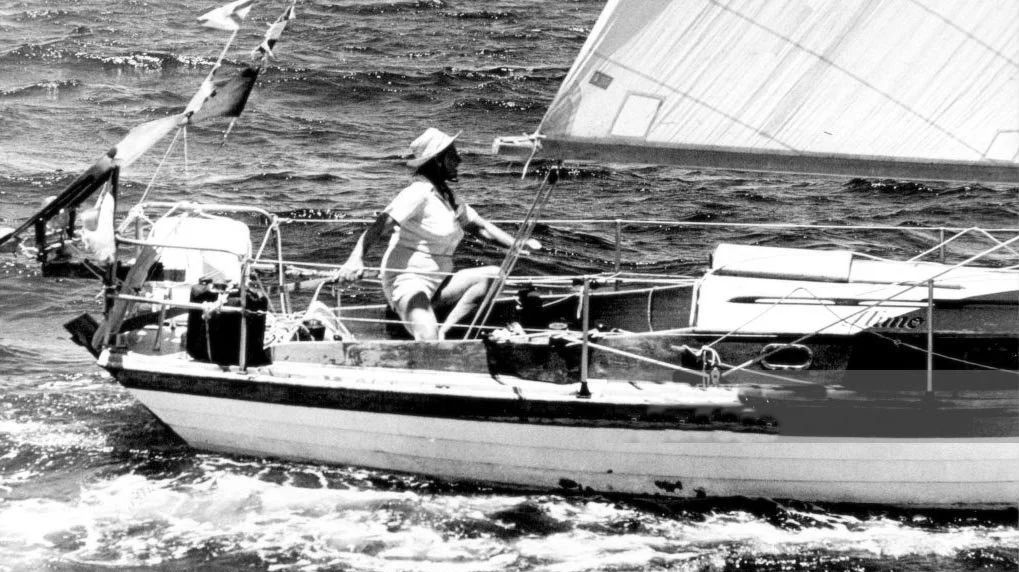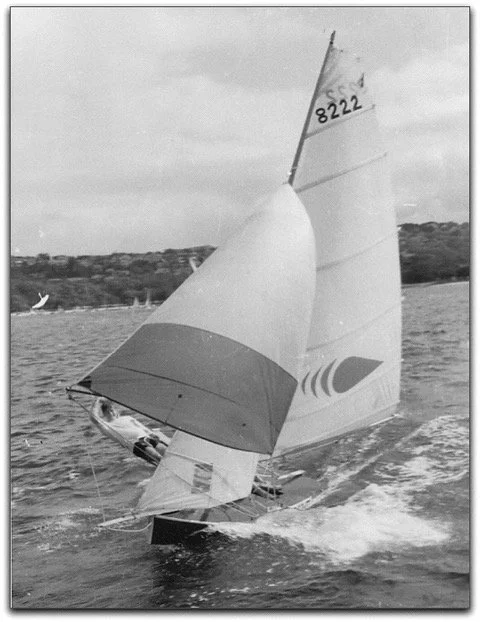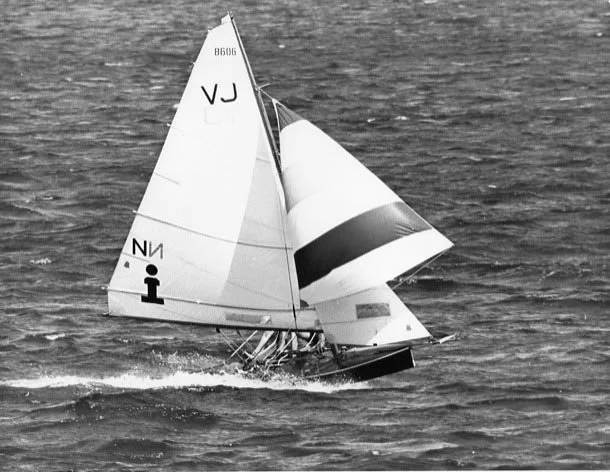Mangroves & Mudflats
by Malcolm Lambe
Looking towards Scotts Guesthouse and Bushrangers Hill 1899
In the 1950s we lived on the Pittwater waterfront at Crystal Bay, Newport – opposite the Royal Prince Alfred Yacht Club. In those days the bay was mangroves and mudflats – the marina and that ugly block of units weren't there and the RPAYC wasn't anywhere near as big as it is now.
Crystal Bay Today
There was a creek running into the head of the bay and the banks were covered in aboriginal midden heaps – deep mounds of discarded oyster shells that had accumulated over hundreds if not thousands of years of aboriginals having their dinner there. The midden heaps would have been even bigger in the previous century before they were collected and burnt to make lime for mortar.
My father built a twelve foot ply dinghy from a kit – probably from Nock & Kirbys - and named it SLICK CHICK. Dad was a survivor of Japanese P.O.W. camps of World War II – including the Sandakan atrocity. He told me much later that he found rowing the boat and fishing with handlines calmed his Post Traumatic Stress somewhat. By the way… what happened to those lines wound around tubes of cork? They were so easy to cast. You can’t buy them anymore. Everything is plastic. Although I did find some secondhand ones.
SLICK CHICK in Crystal Bay
He stashed SLICK CHICK in an old roofless boatshed which had a broken and rusty winch at the back. (and I have an idea that winch is now a "lawn feature" on one of the waterfront house there now) Although quite heavy, the dinghy used to row very well and was quite stable.
My brother and I would take it out from time to time. If it were low tide we'd have to skid it on the keel over three or four oars placed on the mud flats. It took some doing. He was eight and I was eighteen months younger. Mostly we'd just row around the bay or up to the public wharf near Newport Arms – each on one of the heavy timber oars. But then we got hold of an old canvas sail from somewhere and we jury-rigged up a mast by lashing the oars together and we'd set off down Pittwater. If a southerly got up we'd have to get someone to tow us back to Newport but mostly we just sailed and rowed back. It took forever and I'd end up with blistered hands.
Sixty years later I look back on this and marvel at how adventurous we were. We never told our parents of these excursions. For all they knew we were just mucking about fishing and spearing the odd blue-swimmer crab. A favourite spot for that was the Winjijimmi mangrove swamp on the opposite shore that lead to where Pittwater High and the golf-links are now. That was always teaming with bream and whiting. There were oysters and birds up there as well. To us it was like something out of "Swallows & Amazons". A mate and I used to paddle a flat-bottomed ply canoe up it.
Duck Shooting in CrystalBay
Some years later, as a teen, I sailed to the Reef with his mother Ann Gash in a 25 foot Tophat, had a blazing row with the skipper – after he’d run us aground for the third time – got off the boat at Heron Island and left them to it. Ann went on to sail around the world solo in her Folkboat...returned to Sydney a couple of years later and put it on the bricks below Barrenjoey Lighthouse. Total write-off. Local “colourful identity” private investigator Tim Bristow was first on the scene in his speedboat the “See You Off Club”.
Anne Gash aboard her tiny Folkboat ILLIMO
We moved to Bayview – just up from The Bayview Yacht Racing Association and I learnt to sail on Sabots and Manly Juniors. I then taught other kids to sail. I didn't have a boat of my own so I did a few seasons crewing on a hot VJ at the club but the skipper was a “win at all costs” spoilt private schoolboy from the North Shore that used to yell and scream and sometimes hit me so I gave it the flick. Those VJs were very exciting to sail. Especially under a kite. Throwing the pole around the jib before a gybe was something else. We did quite well in the BYRA competition and once won the morning and afternoon VJ races of The Pittwater Regatta.
The old man was having drinks with some neighbours one day and was offered the cotton sails and rig off an old VJ. He decided to convert SLICK CHICK into a sailing dinghy. Except he didn't have a clue about CLR (Centre of Lateral Resistance) or COE (Centre of Effort) and just arbitrarily cut a slot in the bottom of the boat and built a fin case for the duralium (a copper-aluminium alloy) centreboard that came with the VJ stuff. Same for the mast. He just whacked it in front of the fin. So of course the bloody thing would never sail right and we ended up taking it back to a rowing dinghy.
Around this time the father of a fellow VJ sailor offered me a gig forward-handing their VJ on Sydney Harbour for a Woolworths T-Shirt TV spot he was directing. Things were going great until a southerly-buster came in and we capsized again and again and again in amongst the heavy traffic on the harbour. And being only in t-shirts and shorts we froze our arses off. I never did see that ad. We didn’t have a television. But the kids at school saw it so I had my fifteen minutes of fame.
Come to think of it...soon after the Woolies commercial I auditioned for the lead in “Skippy”. No, not the kangaroo – Sonny the ranger’s son. I didn’t get it but they offered me another part. As a walk-on. An extra. When I got home and told my mother she laughed-out-loud so I didn’t pursue it. “What’s wrong Skip?”...”Mal didn’t get the gig”.
Garry Pankhurst ended up getting the role of Sonny Hammond
With the fee I was paid for the TV spot I managed to buy a VJ of my own. My father drove me down to a place up from the iceworks near Newport Arms and we bought the boat without sailing it first. Big mistake. It leaked like a bloody sieve. I can’t remember its name but I renamed it “Bunyip”. Bloody stupid name on reflection. “A creature from aboriginal mythology, said to lurk in swamps, billabongs, creeks and waterholes”. I must have been hanging around the Winjijimmi swamp for too long.
The first race I was in we got a very good start and were heading the fleet to windward in a nor-easter off Saltpan when we noticed boats were passing us to leeward. We were taking in water at a rapid rate. I had to abandon the race and beach the boat at Clareville to empty the water out.
Never mind. My father would help me fix it. We spent ages trying to remove the varnish off the hull so we could repair the chines where the water was getting in. Paint stripper wouldn't work. Scraping didn't work. Sanding was way too slow. I got fed up and went for a surf. When I came back a few hours later my Father happily announced he'd removed all the varnish. With a serrated-edged Skarsten scraper. Which left deep grooves in the timber. “It'll buff out” he said. Of course it never did and instead of filling and painting the hull to disguise the grooves we just gave it a few coats of varnish. “No one will ever notice” he said. I wasn't so sure.
To my great humiliation and embarrassment the boat became the laughing stock of BYRA where some wag quickly tagged it “The Steakknife” and I think it was at that point I decided to take up surfing. I picked up a secondhand Gordon Woods from some guy at Cremorne. But that bastard leaked as well. I politely declined the old man's offer to fix the dings and graduated to a new Keyo as soon as I was able to stand and turn.
But I went back to sailing. Of course I did. Gets in your blood doesn’t it? I’ve had a few boats over the years. Always wooden. I’m a timber boat tragic I’m afraid. Plastic boats hold no interest for me. My latest wooden boat EOS is a 67 year old Laurent Giles cutter out of north coast beech and sometimes I steam into Crystal Bay and the memories come flooding back so strong I find myself feeling quite emotional.
Bayview wharf in 1900
Such a pity the bay doesn’t look like it did in the old days. And we aren’t drinking sly grog on the verandah of Scotts Guesthouse or gazing out to VJs flying down towards Scotland Island.
METROPOLITAN QUARTER SESSIONS. THURSDAY JUNE 15 1883.
The Metropolitan Quarter Sessions were resumed at Darlinghurst this morning, before Mr District Court Judge Murray
APPEAL CASE
John T Collins, of Newport near Pittwater, storekeeper, appealed against the decision of the licensing magistrates of the Water Police Court, under which he was fined the sum of £30 for selling whisky on March 14 last, at which time he was not the holder of a publican's Licence. The grounds of appeal were that the appellant was not guilty of the offence with which he was charged, and that the evidence of the informer was not corroborated. Mr Tarloton, instructed by Mr W Roberts, Senior, appeared in support of the appeal, and Mr Backhouse and Sub-Inspector Atwell appeared to show cause why it should not be allowed. In a great measure the case was a rehearing, but some additional evidence was given.Sub Inspector Attwell gave evidence to the effect that appellant’s premises (Scotts Guesthouse) presented the appearance of an hotel, and that he had found considerable quantities of liquor, together with many glasses there.
Evidence was also called to prove that so far as a man named Walter Love was concerned liquor had been sold and paid for at the place. Appellant contended that it was untrue that any such sale had taken place, and called witnesses in support of his contention but it was admitted that he was in the habit of giving people liquor and not charging them for it. The Judge said that he did not intend to upset the decision of the magistrates because he believed, from the evidence now produced, that it was perfectly right. The place was a sly grog shop of a very common character.
Postscript:
There are five Admirals of the Royal Navy in my family. Going right back to Admiral Sir William Rowley in the 18th century. Several were Commanders of West Indies fleets where my GGG Grandfather became Colonial Secretary of Grenada at 19 and held that post for 54 years. Along the way acquiring four plantations with 1000 slaves. (Gulp) One of them – Palmiste Estate - had a large artificial lake that was dug out by French planters 300 years ago – their slaves doing the hard yakka I imagine – to spin their water-powered sugar mills.
Palmiste Estate in Grenada. Completely overgrown now but sugar, coffee and spices were grown there. The lake the French settlers dug out is clearly visible..
I found out quite recently old GGGG had a 50 foot trading cutter built on the River Clyde in Scotland in 1820 – before the Emancipation of the Slaves in 1834. Trading cutters had very deep draughts to pack in heaps of cargo and get around the Customs and Excise duties of the time. The cutter hull was also very beamy. Many had a length to breadth ratio of 3 to 1 with a lot of deadrise. A huge amount of sail could be set on these beamy hulls.
Then there was another relative, Captain Robert Rowley, who commanded a troopship that was part of the fleet under Admiral Cockburn that sailed up and down Chesapeake Bay in 1813 seizing American shipping, disrupting commerce, raiding the ports and burning Congress and The White House during the American War of Independence.
My GG Grandfather was a pioneer settler of “Bungay Bungay” station on the Manning River in 1840 but also had maritime links. He founded a shipping company in Harrington Street, Sydney with a steamer that sank on the notorious Manning Bar – now called “Old Bar” near Taree. He was also a Magistrate sometimes sitting on the bench of the Water Police at Circular Quay.
Look out for a history of the VJs in next weeks edition of SWS













